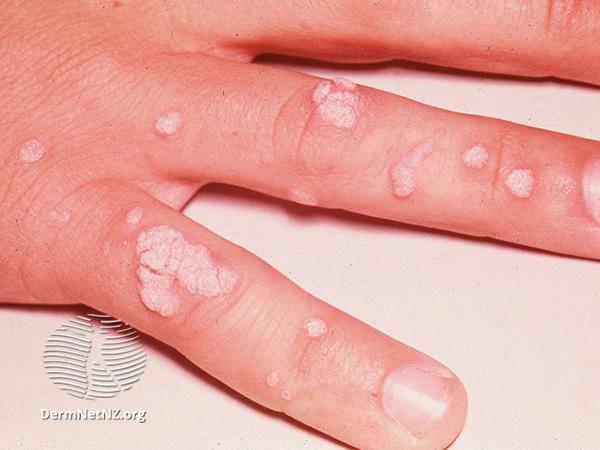Key points about warts
- warts are common, harmless skin growths caused by a virus
- warts can spread between tamariki
- warts can spread to other parts of your child's body when they touch them
- warts will disappear within 2 years in most tamariki
- it is not essential to treat warts, particularly if they are not causing any problems
What are warts?
Warts are generally harmless skin growths. They can grow anywhere on the skin, most commonly on the hands, fingers, feet and face.
Warts are very common, particularly in childhood. It's hard to know exactly how many tamariki will get warts but they may affect up to 1 in 5 tamariki.

A photo of warts on a child's fingers.
Causes of warts
Warts are caused by a family of viruses called HPV (human papillomavirus). Once infected with the virus, it may take up to a year or more before you can see the wart. They then grow very slowly over a period of months to years.
HPV vaccination can protect rangatahi (young people) from genital warts. HPV vaccination is free for everyone from 9 years of age until before their 27th birthday.
See the KidsHealth page on HPV vaccination to learn more.
Human Papillomavirus (HPV) Vaccination
How warts spread
- warts can spread to other parts of your child's body when your child picks or scratches them
- warts can spread to other tamariki who have direct contact with someone with warts
- your child can also get warts indirectly through swimming pools or public showers, especially if they are barefoot and have scratches or cuts
Signs and symptoms of warts
Warts can have many different appearances, from flat, shiny, long stalks, or large rough lumps.
Even without treatment, warts will disappear for most tamariki within 2 years.
Managing warts
It is not essential to treat your child's warts, particularly if they are not causing any problems. Treatment can be more uncomfortable than the warts themselves. No one treatment is guaranteed to work, and many require a few attempts.
However, warts can sometimes cause embarrassment. They can also be painful, particularly when they are on the feet or under nails.
A good approach at first is to keep the warts covered 24 hours a day. Duct tape is simple and cheap, and may help to prevent the warts from spreading.
If you do want to treat your child's warts, there are some treatments you can put on warts.
Special ointments or wart paints
Wart ointments or wart paints are effective in 7 out of 10 tamariki. These ointments and wart paints peel away the layers of infected skin. They can take up to 3 months to work. You can buy wart paints at pharmacies.
How to use wart paints:
- Before using paints, it is important to prepare the skin by soaking the wart in warm water for 10 minutes.
- After soaking the wart, gently rub it with a pumice stone or nail file.
- Put the paint on the wart. Take care to avoid the normal surrounding skin - you can use Vaseline to protect the skin around the wart.
- Let it dry and then cover it with tape.
Liquid nitrogen freezing
Liquid nitrogen freezing is a treatment that can be effective but can be painful. It usually needs to be repeated about every 4 weeks for several months.
When to get medical help for warts
See a health professional if the warts, or their treatment, cause a lot of pain or you are worried.
Acknowledgements
The photo of warts on fingers is reproduced from the DermNet NZ page on viral warts. The photo is reproduced in accordance with the licensing requirements of Creative Commons Attribution-NonCommercial-NoDerivs 3.0 (New Zealand).
References
Kids Health Info for parents: Warts | The Royal Children's Hospital (Melbourne, Australia). Reviewed May 2020.
Viral warts | DermNet NZ. Updated February 2021.
